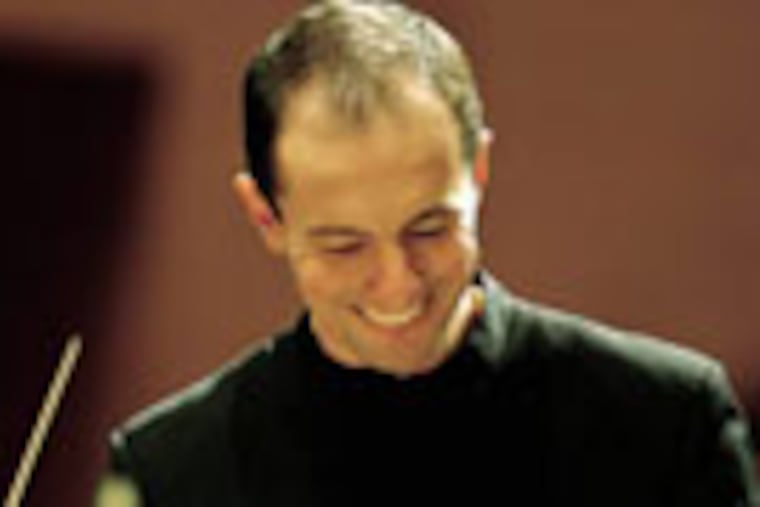Review: Symphony in C hits all its marks
Though only nine minutes away from Philadelphia by train, Symphony in C’s Rutgers-Camden home is truly in another state, which is why the prospect of hearing Gyorgy Ligeti’s Violin Concerto on Saturday at the Gordon Theater felt vaguely perilous. This post-conservatory orchestra and its soloist Augustin Hadelich could be counted on to meet the music’s considerable demands. But what about the suburban audience? The outset was not promising: After a new orchestra piece by Roger Zare titled Green Flash (winner of the orchestra’s annual Young Composers Competition), the audience seemed in no mood to be shoved out of its comfort zone. Green Flash (whose title refers to an atmospheric condition at sunset) was not at fault. It’s a thoroughly accomplished piece that begins with references to Wagner’s Das Rheingold and any number of symphonies by Martinu before moving into its own dreamy orchestral world reminiscent of Kaija Saariaho’s orchestral textures. Though contemplative, the piece never feels static and has its own stealthy narrative. I’d love to hear it again.

Though only nine minutes away from Philadelphia by train, Symphony in C's Rutgers-Camden home is truly in another state, which is why the prospect of hearing Gyorgy Ligeti's Violin Concerto on Saturday at the Gordon Theater felt vaguely perilous. This post-conservatory orchestra and its soloist Augustin Hadelich could be counted on to meet the music's considerable demands. But what about the suburban audience?
The outset was not promising: After a new orchestra piece by Roger Zare titled Green Flash (winner of the orchestra's annual Young Composers Competition), the audience seemed in no mood to be shoved out of its comfort zone. Green Flash (whose title refers to an atmospheric condition at sunset) was not at fault. It's a thoroughly accomplished piece that begins with references to Wagner's Das Rheingold and any number of symphonies by Martinu before moving into its own dreamy orchestral world reminiscent of Kaija Saariaho's orchestral textures. Though contemplative, the piece never feels static and has its own stealthy narrative. I'd love to hear it again.
Ligeti's 1993 concerto, however, is harder to parse from a coherence standpoint. The violin soloist plays a beautifully melancholic solo in the second movement only to be visited, from a rather alien key, by a consort of ocarinas (which American audiences think of as primitive children's instruments). That's only one instance of the piece's surrealism. Alluring swarms of sound do give the piece a sensual element, but music director Rossen Milanov rightly emphasized the music's lean clarity of imagery. Some conductors try to sweep its more eccentric elements under the rug of a larger orchestral texture. Not Milanov.
Whether or not that imagery is supposed to converge into a meaningful statement, Hadelich and Milanov masterfully framed the piece with a traditional sense of pacing, light and shade, tension and release, beginning and end, that drew you so much into this idiosyncratic world that you no longer needed to probe it for logic. It effectively seeped into your consciousness. By the end, the music no longer seemed difficult, in what was a fully satisfying if rather alternative musical experience. Hadelich delivered an incredibly smooth and concentrated melodic line with his distinctive, shimmering tone quality. You couldn't hope for a more inviting performance.
The second half, Dvorak's ultra-popular Symphony No. 9 ("New World"), could have felt like a rerun, yet many passages were so magnetic that past performances of this piece fell completely from my memory. Even knowing every inch of this symphony, I often asked myself how Dvorak was going to find his way out of the many musical outposts it contains. Milanov has become the master of fluid, graceful transitions, not just between sections but when ideas more organically grow out of what came before. And when the connecting material feels so artistically ingenious, one has new appreciation of the events being connected. Rarely has this symphony seemed so loaded with diverse ideas. We all know about the folk music in the piece, but others sections sounded like a consort of antique viols.
Emotionally speaking, the piece is the apotheosis of homesickness, and Milanov clearly showed the composer's way of conveying this: The warm, safe sound world of the second movement was animated by always finding one more thing to say, as if wanting to stay in that world forever but being unable to do so. Does that explain the symphony's unceasing popularity?
Contact music critic David Patrick Stearns at dstearns@phillynews.com.